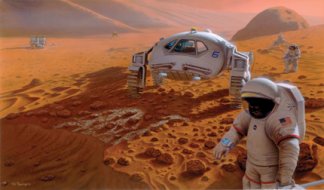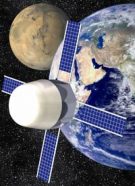Destination Mars
Sending mice into space is just one step toward putting astronauts on Mars.
By Emily Sohn
If you’re lucky, you might someday walk on the surface of Mars.
For some scientists, the question is no longer whether people will ever get to Mars. It’s a question of when people will travel there. The most cautious of the bunch say it may take many decades to overcome the obstacles standing in the way of such an expedition. Others are more optimistic.
“I’d like to think that missions will be going there as early as 15 years from now,” says Paul Wooster. He’s director of the Mars Gravity Biosatellite Program at the Massachusetts Institute of Technology (MIT).
 |
|
This illustration gives an artist’s impression of what a human expedition to the surface of Mars might look like.
|
| P. Rawlings/NASA |
Whether or not you want to go to Mars yourself, the Red Planet is exciting. Two radio-controlled robots, named Spirit and Opportunity, are now exploring the planet. The rovers are sending back amazing images and information about places that scientists had never before studied in such detail.
Meanwhile, President Bush recently proposed giving the National Aeronautics and Space Administration (NASA) $12 billion over the next 5 years for space exploration. He committed the United States to the goal of getting astronauts back to the moon by 2020 and then going beyond.
“We do not know where this journey will end, yet we know this: Human beings are headed into the cosmos,” President Bush said in January.
Mice in space
Before any of us can vacation on Mars, though, there are still plenty of complications to iron out. Some of the biggest questions have to do with the human body. We are fine-tuned to deal with conditions here on Earth. How our bodies might react to living on another planet is anybody’s guess.
Gravity, in particular, is a big concern. Because Mars is smaller and less massive than Earth, its gravity is weaker than Earth’s. A person weighing 100 pounds on Earth would weigh just 38 pounds on Mars. What’s more, astronauts would experience zero gravity during the year or more of travel time going to and from Mars.
When astronauts spend time in zero gravity, their muscles and bones break down. It’s as if they had been lying motionless in bed for a long time. If astronauts don’t do weight-bearing exercises while they’re in orbit aboard the space shuttle or space station, it can be difficult for them to walk when they get back. The longer astronauts spend in space, the longer it takes them to recover.
A mission to Mars would last at least two and a half years, including travel time. That’s much longer than anyone has previously spent in outer space.
To find out how mammals might fare on Mars, Wooster is planning to send 15 mice into outer space. Each mouse will have its own cage. For 5 weeks, the spacecraft will spin just enough for the mice to experience the gravitational pull found on Mars.
 |
|
This illustration shows what the Mars Gravity Biosatellite would look like in orbit.
|
| Georgi Petrov, Mars Gravity Biosatellite Program, MIT |
Over the course of the mission, Wooster and his collaborators (which include more than 100 college students around the world) will monitor the health and activity levels of the mice.
Each cage will be built to collect urine samples on cloth pads underneath a mesh barrier at the bottom of the cage. Every few days, an automated system will roll up and store the urine-soaked pads. When the mission returns to Earth, the scientists will look at chemical markers in the urine to measure how quickly muscles and bones break down.
“This is going to be the longest, partial-gravity study on mammals in space,” says Wooster, who hopes to launch the mission as early as 2006.
What happens to mice could also happen to people. The data that researchers collect will help determine how much exercise and what types of activity Mars travelers might need to stay healthy and strong for the entire trip.
And there are other complications.
Mars doesn’t have any grocery stores or fast-food restaurants. Plants don’t even grow there. And the rovers still haven’t found pools of liquid water on the planet. So, astronauts will have to bring all their food and water with them—enough to last several years.
Also, it will be impossible for people to breathe Martian air, which is 95 percent carbon dioxide. Earth’s atmosphere is 78 percent nitrogen, 21 percent oxygen, and about 0.035 percent carbon dioxide. Astronauts will need reliable spacesuits, pressurized vehicles, and airtight shelters to survive on Mars.
Heavily insulated clothes will also be essential. Because Mars is farther from the sun than Earth, it gets extremely cold in winter, with temperatures as low as –111 degrees Celsius. And a Martian year lasts 687 Earth days.
Planetary research
Putting people on Mars would be a huge boost for planetary research, Wooster says.
“In a couple of hours at most, an astronaut can do pretty much everything the rovers there are doing currently,” he says. “And an astronaut can do it much better and more comprehensively.”
 |
|
Panoramic view of a Mars landscape, as photographed by the rover Spirit.
|
| NASA/JPL |
Already, Spirit and Opportunity have turned up some interesting findings about the rocks, dirt, and landscape of Mars. Opportunity, for instance, dug a trench with its front wheel. Analyses showed that the soil composition changes with depth. The way the soil is packed together suggests the presence of small amounts of water in the past.
On the other side of the planet, Spirit found the top layer of soil to be stickier than expected. One possibility is that liquid water in the soil that was once present in the soil combined with salts to produce the stickiness.
Finding water on Mars would be an enormous triumph. Water makes life possible here on Earth. So, finding signs of water on Mars would indicate that life might have existed there in the past and could still lurk there today.
Today, mobile robots are exploring Mars. In a few years, mice may experience Mars in their own way. Looking farther ahead, you might be the one who gets to stroll across the Red Planet’s dusty surface.
Going Deeper:







